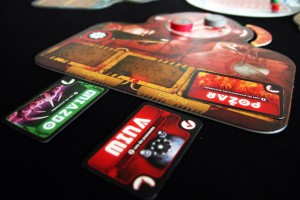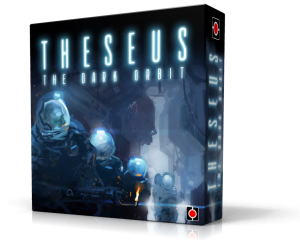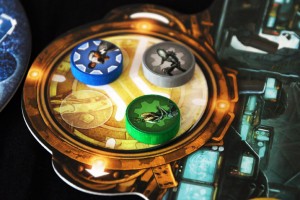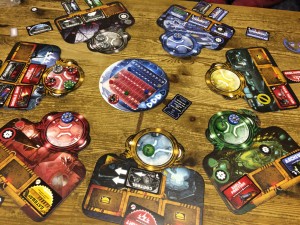Review: Theseus
Posted by James (admin) on January 20th, 2014
Theseus is a sci-fi game set on a space station where the different factions (soldiers, scientists, aliens and greys) are trying to take control. The setting and photos may give the impression it’s a complicated game, but it’s actually a eurogame that is relatively quick and contains some good tactical play.
THE GAME
Players take turns moving their units around different locations (sectors) on the space station. Each sector is a separate board piece and these are arranged in a circle: one sector for each player’s faction, plus one each for the Corridors, Control Room and Tech Bay. Each sector has 4 rooms (in the circular area) as well as several spaces for action cards (the oblong areas) which players will place during the game. Each player has their own unique deck of action cards. These first enter the game by being placed next to sectors (called ‘pending’ cards) which may get to be placed (‘installed’) on a sector later.
On their turn, a player must move one of their 3 units a number of sectors clockwise equal to the number of units currently on the unit’s starting sector, i.e. if there are 2 units on a sector, then a unit moved from there moves 2 sectors clockwise. A moved unit is placed in one of the 4 rooms (arranged in a 2 x 2 grid) on the sector they move to. Some rooms have walls between them which block combat. If all 4 rooms are full, the arriving player ejects one of the units there into space and takes their position. If a unit’s move means all the rooms in the sector are now full, all units belonging to the player whose turn it is attack other units in that sector. (Only soldiers start with combat ability; whereas, other factions’ units need upgrading first.)

This is one of the sectors. One card is already installed in the sector (with two pending) and two units are in rooms in the sector too.
After moving, the player resolves all of their own action cards that are already installed on the sector where their unit just arrived. These can trigger combat, healing, gaining data, abduction, and lots, lots more. The player then performs the sector’s action: for example, the Tech Bay sector lets you take another turn with a different unit, and the Corridors sector lets you attack with all your units in all sectors. The sector action on each player’s home sectors can only be used by the relevant player and primarily offer the opportunity to upgrade units or card effects.
Finally, the player deals with pending cards next to the sector where they finished their move. If there are any empty slots, they can place the next action card from their deck as pending card. If there are any enemy pending cards, the player can discard one and replace it with one of their own (which becomes a pending card). However, if one of their own pending cards is present, they can install it (place it) on any space on any sector not already occupied by an installed card.
The soldiers and aliens win by reducing a faction from 20 down to zero life points, and the scientists and grey win by collecting 20 points worth of data about their enemy. The game can also end when the ‘End’ token moves 4 times and it’s moved whenever a player needs to place a card but has none in their deck – in this case, the player with the highest total of life points remaining plus data collected wins. With 3- and 4- player games, players don’t track their own health level and it’s purely about causing 20 life points or collecting 20 data points.
 THOUGHTS
THOUGHTS
Theseus is an interesting eurogame weighted towards making short-term decisions more than long-term plans. The movement system reminds me of the one used in Finca which is a good thing in my eyes.
On a player’s turn, each unit has just one possible destination, so a player only ever has a maximum of 3 options to pick from (sometimes only 1 if all your units are in the same sector) on their turn and this keeps the game moving.
However, whilst you may only have a maximum of 3 movement options, there is still plenty to consider, such as: What pending cards are at the possible destinations that you could install/discard? What action cards could you trigger (and who would you use the effects on)? What sector actions would you trigger? What enemy trap cards would you walk into? Where could you cause combat (or collect data)? Plus, where you move your unit from and/or to can also affect your opponents’ movement on their turn too (as well as setting up your next movement). So, you may only have up to 3 movement options but the choice between them can be a very interesting one.
Each faction has a deck of 25 action cards but only 15 are used (at random) each game which adds variety in replay. Each deck is very different which works well to give each of the 4 factions their own unique feel and require different tactical approaches. I like how the cards have the big title, short description and artwork on the front and a detailed description of their use on the back. I have found the wording on them to be very precise too like well-written rules should be.

There are 3 units in rooms on this sector. The blue and grey are separated by a wall so can not attack each other even if they have the ability.
As each faction has its own unique deck of action cards, playing different combinations of factions against one another also adds good variety too. The fifth faction (which sounds ideal for a use in a 3-player game) is very intriguing as it has no action cards of its own but leeches off of other faction’s action cards (and spawns units each time it moves).
With regards to drawbacks, the key one for me is that the game becomes more chaotic with more players. I really liked the 2-player game as you can really start to look at how to manipulate the board with your moves and actions in order to create some big effects. However, so much happened on the board between my turns in a 4-player game that I found it hard to create any longer-term tactics, and I couldn’t really start planning my turn until just before my go. I managed to win a 4-player game by causing all 20 points of damage required in one turn (and I already had caused 10) – I had installed a couple of action cards in a specific sector but, as much as I’d like to think it was strategic genius, I have to admit I felt it was more fortune than planning that created the perfect position of units that allowed me to trigger it.
The other drawback is that the cards in your deck can make a big difference to your tactics (and performance). This is a minor drawback and it can be overcome by having players drafting, or selecting, cards into their deck.
Overall, I think Theseus is an excellent, tactical game when played with 2-players – I felt I had more control over what would happen in the next few turns and it allowed me to create situations into which I was trying to trap my opponent. With more than 2 players, the game felt a bit chaotic with less control but it still remained interesting and turns came around quickly. There was a feeling of anticipation to take your next turn and there’s no time to hold back as Theseus has a surprisingly short playing time. Each faction is interesting and offers ways to combine your action cards for powerful effects, and there’s lots of scope for ‘humorously’ screwing over your opponent(s). There are no dice so the only luck factor in the game is in the order in which you draw your cards. Whilst I found 4-players was less satisfying, I’m looking forwards to playing Theseus lots more as a 2-player game.
If you want to learn more, you can read the rules and see the details of the game on Portal’s web site using this link: bga.me/theseus
James.
[Played with 2 and 4 players]



January 22nd, 2014 at 12:43 pm
[…] Theseus got reviewed by Metagames. […]